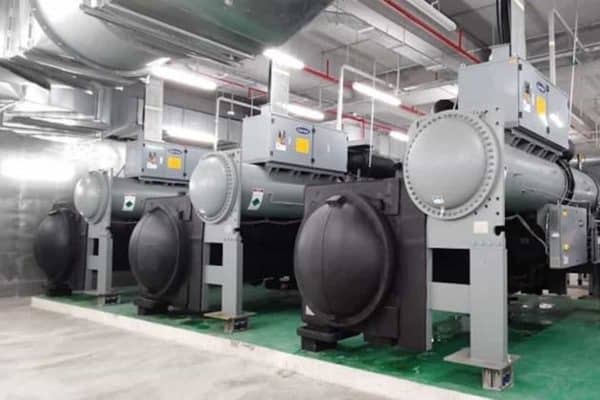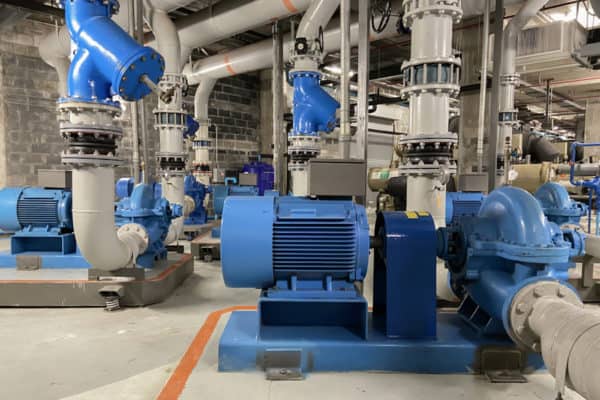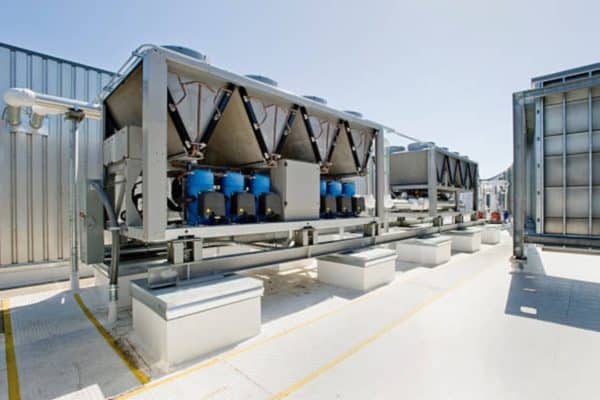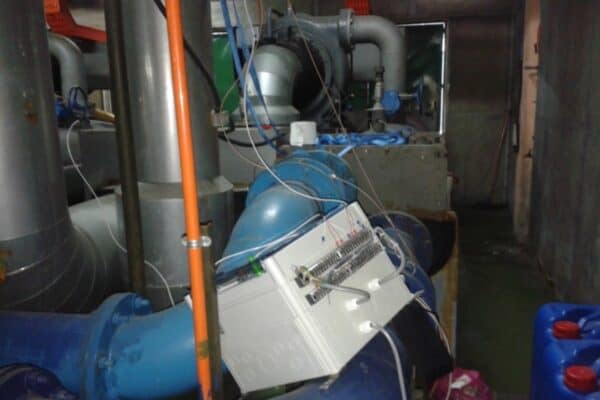What is High Delta T Chilled Water Systems?
More and more chilled water systems are adopting high delta T design. Many design engineers are wondering what exactly is high delta T chilled water systems? So, I did some research.
High delta T chilled water systems have a temperature difference of about 15°F (8°C) between the chilled water supply and return while standard chilled water systems have a temperature difference of about 10°F (5.5°C) only. High delta T chilled water systems are more efficient.
Many engineers wish to design a high delta T chilled water system to improve energy efficiency. However, many of them are not clear about the different aspects associated with high delta T systems.
High Delta T vs Standard Delta T
High delta T chilled water systems supply chilled water at about 42°F (5.5°C) while standard delta T chilled water systems supply chilled water at about 44°F (6.7°C).
As for the chilled water return temperature, high delta T chilled water systems are at about 57°F (13.8°C) and standard delta T chilled water systems is at about 54°F (12.2°C).
| Chilled Water | High Delta T | Standard Delta T |
|---|---|---|
| Supply Temperature | 42°F (5.5°C) | 44°F (6.7°C) |
| Return Temperature | 57°F (13.8°C) | 54°F (12.2°C) |
How to Achieve High Delta T?
High delta T is achieved by reducing the water flow rate. It can be explained by the following formula:
Q = mcθ
or
Capacity = Mass Flow Rate x Specific Heat Capacity x Temperature Difference
Since the specific heat capacity is constant, the flow rate must be decreased in order to increase the temperature difference (delta T) while maintaining the same capacity.
For every one delta T increase from 10°F (5.5°C), the water flow rate drops about 8% on average.
| Delta T Increase | Water Flow Reduction |
|---|---|
| 1°F (0.5°C) | ~10% |
| 2°F (1.0°C) | ~9% |
| 3°F (1.5°C) | ~8% |
| 4°F (2.0°C) | ~7% |
| 5°F (2.5°C) | ~6% |
Therefore, high delta T chilled water systems have smaller pumps. But, the cooling coil of AHUs and FCUs is bigger and denser (more fins), requiring more fan power to push the air through the coil.
Why High Delta T?
High delta T chilled water systems are more efficient because pumps are consuming lesser power during operation. Furthermore, the initial cost of pumps and pipes is significantly lower due to the reduced water flow rate.
These savings are amplified further for chilled water systems with long pipes. For example, district cooling systems and chilled water systems in tall buildings.
According to ASHRAE standard 90.1, chilled water cooling coils must be at least have a delta T of 15°F (8°C) and the chilled water return temperature must not be lower than 57°F (13.8°C). The requirement was intended to promote the use of coils with large heat transfer areas.
Although high delta T will increase the fan power consumption due to the bigger coil, the saving from pumps and pipes are more than sufficient to offset it.
Thus, more and more chilled water systems are adopting high delta T design. However, there are also many problems associated with high delta T chilled water systems.
On a side note, if you want to quickly learn about chilled water system, you can get my Chilled Water System (eBook). If you’re into design, you can enroll in my Chilled Water System Design Course where I teach you various design procedures with tons of examples.
Chilled Water System Design Course
Learn how to design a chilled water system with AHU/FCU selection, chiller sizing, cooling tower sizing, pump sizing, piping design, ductwork design and more.
Common Problems in High Delta T Chilled Water Systems
One of the common problems associated with high delta T chilled water systems is incorrect air-side equipment selection, not accommodating low chilled water flow rate.
1. Incorrect Air-Side Equipment Selection
In high delta T chilled water systems, the chilled water flow rate and temperature are lower than traditional delta T systems. Hence, all AHUs and FCUs cooling coil need to be larger or have more rows.
Problems with the cooling coil of air-side equipment are more common in retrofit projects where the owner of a building wants to reduce electricity cost by using high delta T chillers but not replacing all the AHUs and FCUs that are not designed for high delta T.
If the AHUs and FCUs are not upgraded to accommodate the high delta T design, the chilled water return temperature will not meet expectations. In a district cooling system, a penalty may be imposed for high chilled water return temperature.
2. High Humidity Problem
In some cases, building operators may increase the chilled water flow rate and supply temperature simply to meet the required chilled water return temperature. However, such an action will lead to all sorts of humidity problems such as mold and fungus growth.
High delta T must be achieved by the combination of low chilled water flow rate, good water flow control and appropriate cooling coil selection. Increasing the chilled water supply temperature to achieve high delta T may cause long-term mold growth issues.
The average chilled water temperature must be low enough to ensure that the surface of the cooling coil is cold enough for condensation and thus, dehumidification. This is especially critical in hot and humid countries.
For instance, the cooling coil surface temperature must be equal to or lower than 58°F (14.4°C) to achieve 55% relative humidity at a room temperature of 75°F (24°C).
If the chilled water supply and return temperature is set to about 46.5°F (8°C) and 61°F (15°C) respectively to meet whatever requirement, many places will be high in relative humidity, causing serious mold problems.
3. Space Constraint
When designing a high delta T chilled water system, one must expect the AHUs and FCUs to occupy more spaces and thus, making sure sufficient floor area is reserved. Otherwise, HVAC manufacturers have no choice but to select smaller AHUs and FCUs that may not be suitable for high delta T.
4. Inaccurate Water Flow Control
Water flow control valves play an important role in making sure accurate and precise chilled water flow is being fed into each AHUs and FCUs. If too much water is let into an AHU or FCU, high delta T can’t be achieved.
Pressure-independent control valves often have better accuracy depending on the manufacturer of the valve. However, incorrect sizing of control valves also leads to inaccurate water flow control.
Low Chilled Water Supply Temperature
Most of the time, the chilled water supply temperature does not fall further into the range of about 38-40°F (3.3-4.4°C) because the cost of the chillers may outweigh the saving from the rest of the equipment.
Besides, certain regions in the world may not have a high enough wet bulb temperature for cooling towers to cool the condenser water sufficiently in order to achieve such a low chilled water supply temperature.
Furthermore, to achieve such a low chilled water supply temperature, the evaporator tube of chillers needs to be longer and thus, the physical size of the chillers is larger which occupies more spaces.
If chillers are required to have more passes to achieve such a low chilled water supply temperature, the water pressure drop is high and more pumping power is needed which offsets the saving from the high delta T setup.
Conclusion
Pumps and pipes’ initial cost can be significantly reduced in high delta T chilled water systems. At the same time, less pumping power is required and thus, high delta T chilled water systems are more efficient.
High delta T chilled water systems usually have a chilled water supply and return temperature of about 42°F (5.5°C) and 57°F (13.8°C) respectively. Hence, the temperature difference or delta T is about 15°F (8°C).
By reducing the water flow rate, high delta T can be achieved. However, proper cooling coil selection coupled with appropriate water flow control is part of the high delta T recipe.
Increasing the average chilled water temperature may temporarily achieve high delta T but it’ll cause long-term humidity problems such as mold and fungus growth.
Once again, you can get my Chilled Water System (eBook) to quickly learn more about chilled water system. But, if you want to learn how to design a chilled water system from start to end, I encourage you check out my Chilled Water System Design Course.
Chilled Water System Design Course
Learn how to design a chilled water system with AHU/FCU selection, chiller sizing, cooling tower sizing, pump sizing, piping design, ductwork design and more.
If you have anything to add (or ask) about this topic, leave a comment down below!










Kindly explain the effect of the evaporator entering temperature from 9 deg c to 12 deg C
I assume you refer to AHU evaporator entering water temperature. If so, increasing it from 9C to 12C will lead to high supply air temperature (~15C) which can cause undercooling and high humidity issues. However, on the flip side, the chiller power consumption will reduce (see https://aircondlounge.com/how-chilled-water-temperature-affects-chiller-performance/).